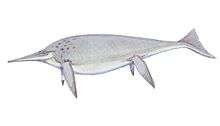Aegirosaurus
Aegirosaurus is an extinct genus of platypterygiine ophthalmosaurid ichthyosaurs known from the late Jurassic and early Cretaceous of Europe.
| Aegirosaurus | |
|---|---|
| Fossil tail and fluke | |
| Scientific classification | |
| Kingdom: | Animalia |
| Phylum: | Chordata |
| Class: | Reptilia |
| Order: | †Ichthyosauria |
| Family: | †Ophthalmosauridae |
| Subfamily: | †Platypterygiinae |
| Genus: | †Aegirosaurus Bardet & Fernandez, 2000 |
| Species: | †A. leptospondylus |
| Binomial name | |
| †Aegirosaurus leptospondylus (Wagner, 1853) | |
| Synonyms | |
| |
Discovery and species
Originally described by Wagner (1853) as a species of the genus Ichthyosaurus (I. leptospondylus), the species Aegirosaurus leptospondylus has had an unstable taxonomic history. It has been referred to the species Ichthyosaurus trigonus posthumus (later reclassified in the dubious genus Macropterygius) in the past, and sometimes identified with Brachypterygius extremus. In 2000, Bardet and Fernández selected a complete skeleton in a private collection as the neotype for the species I. leptospondylus, as the only other described specimen was destroyed in World War II. A second specimen from the Munich collection was referred to the same taxon. Bardet and Fernández concluded that the neotype should be assigned to a new genus, Aegirosaurus. The name means 'Aegir (teutonic god of the ocean) lizard with slender vertebrae'.[1]
Within the Ophthalmosauridae, scientists once believed Aegirosaurus was most closely related to Ophthalmosaurus.[2] However, many recent cladistic analyses found it is more closely related to Sveltonectes (and probably to Undorosaurus). Aegirosaurus lineage was found to include Brachypterygius and Maiaspondylus, too, and to nest within the Platypterygiinae, which is the sister taxon of Ophthalmosaurinae.[3][4]
Stratigraphic range
Aegirosaurus is known from the lower Tithonian (Upper Jurassic) of Bavaria, Germany. Its remains were discovered in the Solnhofen limestone formations, which have yielded numerous well-known fossils, such as Archaeopteryx, Compsognathus, and Pterodactylus.
In addition to its late Jurassic occurrence, Aegirosaurus has recently been discovered from the late Valanginian (early Cretaceous) of southeastern France (Laux-Montaux, department of Drôme; Vocontian Basin), the first diagnostic ichthyosaur recorded from the Valanginian.[5] This shows that most types of late Jurassic ichthyosaurs crossed the Jurassic-Cretaceous boundary.
Palaeobiology
It was a small genus of ichthyosaur, with adults being less than 2 metres (6.6 ft) in length.[1] Tooth morphology and wear pattern suggest that Aegirosaurus belonged to the "Pierce II/ Generalist" feeding guild.[5]
See also
- List of ichthyosaurs
- Timeline of ichthyosaur research
References
- Bardet, N; Fernández, M (2000). "A new ichthyosaur from the Upper Jurassic lithographic limestones of Bavaria". Journal of Paleontology. 74 (3): 503–511. doi:10.1666/0022-3360(2000)074<0503:aniftu>2.0.co;2.
- Fernández, M (2007). "Redescription and phylogenetic position of Caypullisaurus (Ichthyosauria: Ophthalmosauridae)". Journal of Paleontology. 81 (2): 368–375. doi:10.1666/0022-3360(2007)81[368:rappoc]2.0.co;2.
- Fischer, Valentin; Edwige Masure, Maxim S. Arkhangelsky and Pascal Godefroit (2011). "A new Barremian (Early Cretaceous) ichthyosaur from western Russia". Journal of Vertebrate Paleontology. 31 (5): 1010–1025. doi:10.1080/02724634.2011.595464.
- Valentin Fischer; Michael W. Maisch; Darren Naish; Ralf Kosma; Jeff Liston; Ulrich Joger; Fritz J. Krüger; Judith Pardo Pérez; Jessica Tainsh; Robert M. Appleby (2012). "New Ophthalmosaurid Ichthyosaurs from the European Lower Cretaceous Demonstrate Extensive Ichthyosaur Survival across the Jurassic–Cretaceous Boundary". PLoS ONE. 7 (1): e29234. Bibcode:2012PLoSO...729234F. doi:10.1371/journal.pone.0029234. PMC 3250416. PMID 22235274.
- Fischer, V.; Clement, A.; Guiomar, M.; Godefroit, P. (2011). "The first definite record of a Valanginian ichthyosaur and its implications on the evolution of post-Liassic Ichthyosauria". Cretaceous Research. 32 (2): 155–163. doi:10.1016/j.cretres.2010.11.005.

